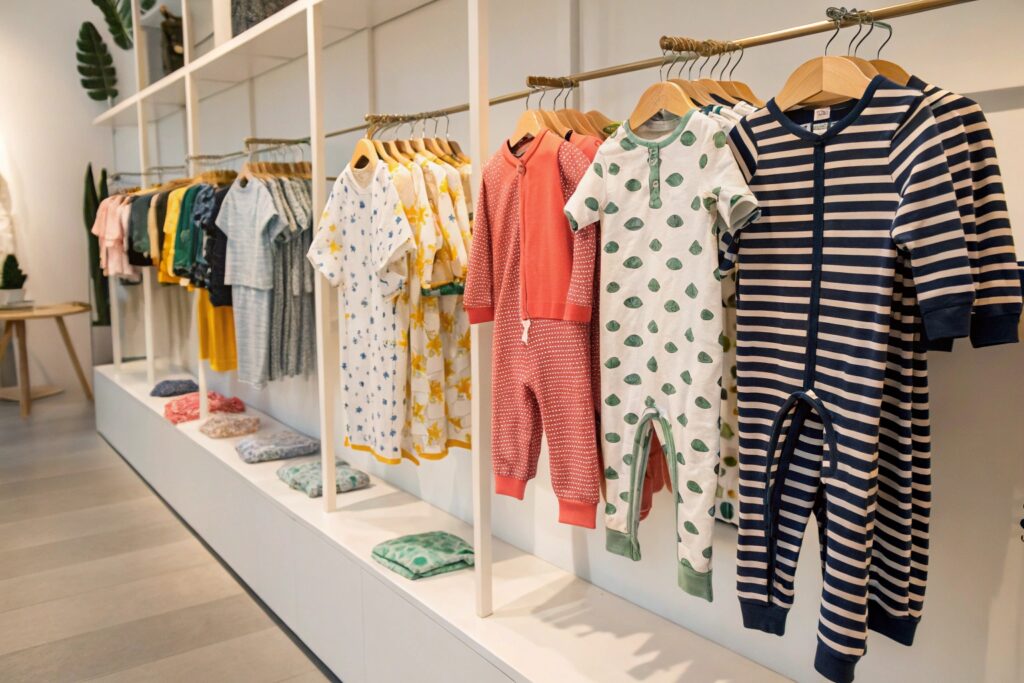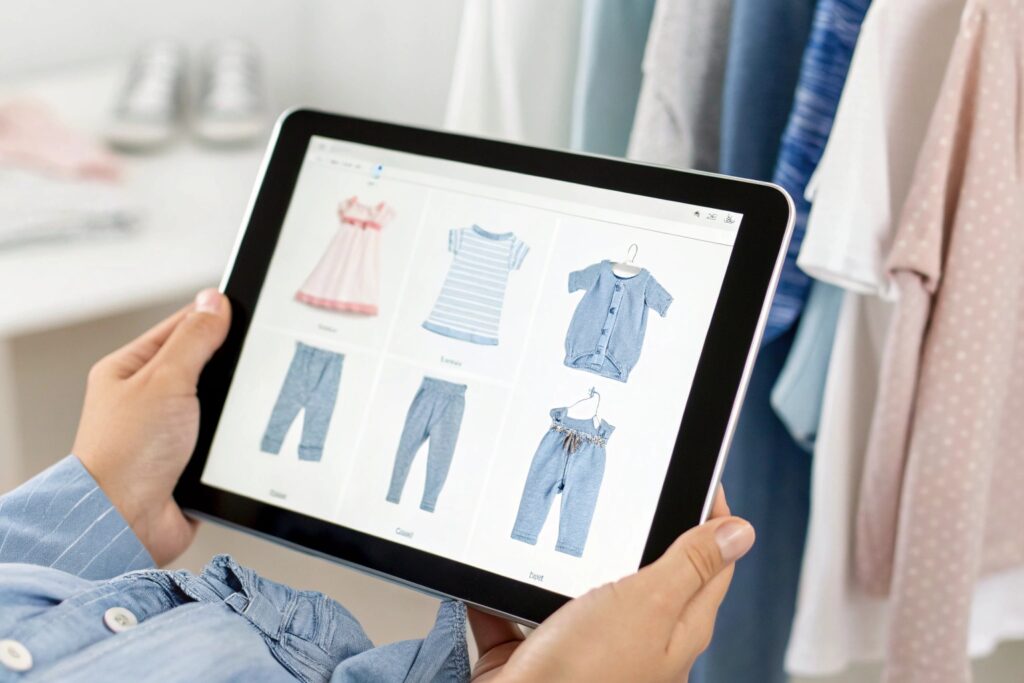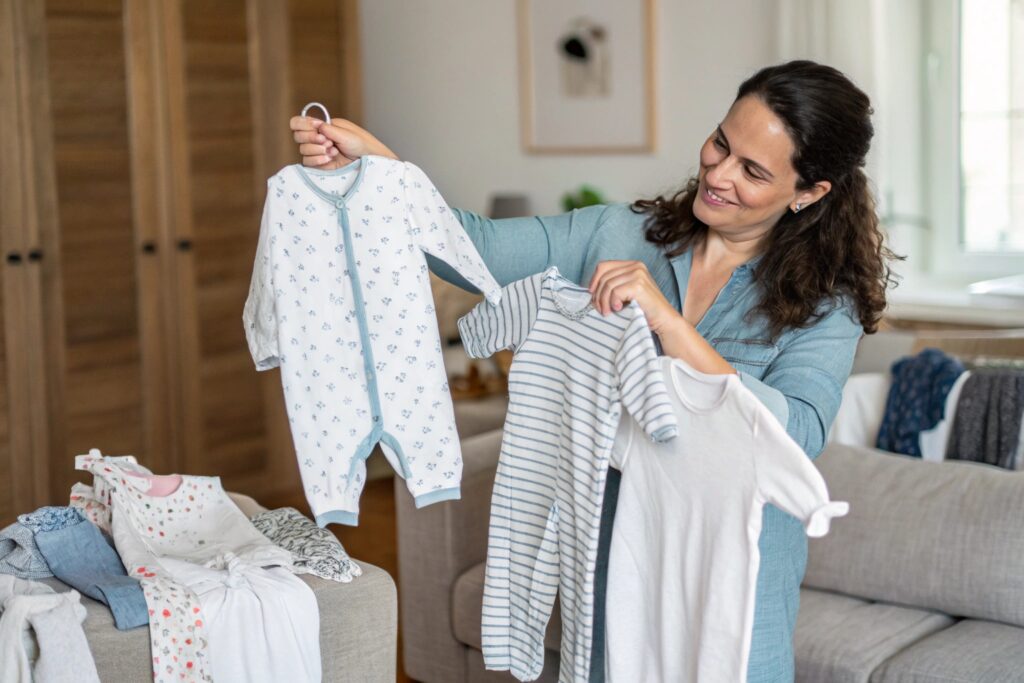Everyone wants a piece of the babywear market. But with so many brands fighting for attention, how can you win?
To stay ahead in the baby clothing market, focus on differentiation, niche targeting, modern parent needs, and smart marketing. It’s not about doing more—it’s about doing it right.
Competing in this space is tough. But with the right mindset and clear strategy, you can turn chaos into opportunity. Let’s break down how to stand out and grow your babywear brand sustainably.
How to Differentiate Your Babywear Brand from Competitors?
Too many baby brands blend into the same soft pastel background. If you want to be noticed, you have to be different—and bold.
Differentiation means having a clear identity, unique value, and consistent style. Whether it’s your materials, your designs, or your messaging—stand for something.

Why do most babywear brands fail to create a memorable brand presence even with high-quality products?
Because they all try to please everyone. They chase the same trends, use the same color palettes, and follow the same Instagram formulas. That makes them forgettable. But parents don’t remember average—they remember bold.
As a manufacturer, I’ve worked with brands that stand out simply by doing one thing differently: some focus only on gender-neutral tones, others use storytelling in every tag. One client launched a full line inspired by vintage travel posters—people loved it because they hadn’t seen it before.
Here’s a quick table comparing two types of brands:
| Feature | Generic Brand | Differentiated Brand |
|---|---|---|
| Logo Design | Simple, vague | Bold, memorable |
| Color Palette | Pastels only | Defined, thematic |
| Messaging | "Soft & Safe" | "Adventure Starts Here" |
| USP | Unclear | Organic, limited-edition only |
Don’t compete on price alone. Compete on value, creativity, or emotion.
How can small babywear companies find their unique voice without expensive branding agencies?
Start simple. Your brand voice is just how you talk to your audience. If you’re funny, be funny. If you’re passionate about sustainability, show that. Use plain language. Avoid jargon. Write the way your ideal customer talks.
Build moodboards. Choose three adjectives that define your style—like “modern,” “friendly,” “clean.” Make sure everything from product design to packaging matches them.
And most importantly: be consistent. Consistency builds recognition. Even if you’re small, a clear and steady brand voice feels big.
Why Niche Targeting Works in the Baby Clothing Industry?
Trying to appeal to every parent usually ends in appealing to none. Niche targeting helps you focus, connect, and convert.
Niche targeting allows you to serve a specific group of parents deeply. It makes your message sharper and your marketing more efficient.

What are some successful niche strategies babywear brands have used to dominate micro-markets?
We’ve seen many clients grow fast by owning a niche. Some focus on cultural heritage—offering traditional embroidery from Mexico or prints from Ghana. Others serve lifestyle segments, like babywear for outdoor lovers or minimalists.
One brand we work with only sells “first 40 days” newborn items, inspired by postpartum care customs. Another only makes matching outfits for twins. They each know exactly who their customer is—and speak only to them.
Here’s how niches often look:
| Niche Segment | Key Message |
|---|---|
| Eco-conscious Parents | "Safe for baby, gentle on Earth." |
| Fashion-forward Moms | "Style doesn’t stop at motherhood." |
| Budget Buyers | "Look good for less." |
| Cultural Communities | "Celebrate your roots in style." |
Choosing a niche doesn’t limit you. It gives you focus. You can expand later—but only after you’ve won your niche.
How does niche targeting help with product development, branding, and ad spending?
It simplifies everything. Instead of guessing what will work, you know what your customers care about. Product decisions become clearer. For example, if you serve outdoor families, you know you need durable fabrics, UV protection, and gender-neutral designs.
Your branding becomes sharper too. Your words, colors, and packaging all speak to a specific lifestyle. That builds trust faster.
And for ads? A niche target audience means lower ad costs. You’re not wasting money on broad terms like “baby onesie.” You can use specific keywords, locations, or even parenting styles. That makes your budget work harder.
What Modern Parents Expect from Babywear Labels?
Today’s parents aren’t just buying clothes—they’re buying into values, identity, and lifestyle.
Modern parents want more than cute designs. They expect transparency, safety, convenience, and alignment with their personal values.

How have parenting trends changed the expectations for babywear brands?
Millennial and Gen Z parents do more research before buying. They care about fabrics, origin, and ethics. They want items that are safe, non-toxic, and easy to wash—but also stylish and Instagram-friendly.
They don’t just look at the product. They check the label, the factory, the carbon footprint, the packaging. A cute romper isn’t enough—it needs a story.
They also expect tech-friendly service: online ordering, fast replies, mobile support, and easy returns. Brands that offer smooth digital experiences build loyalty fast.
What specific product features or brand behaviors do parents now consider non-negotiable?
From working with over 40 babywear brands, here’s what we’ve seen parents ask about most:
| Expectation | What Parents Look For |
|---|---|
| Fabric Safety | OEKO-TEX® or GOTS certification |
| Fit and Comfort | Soft seams, flexible waistbands |
| Transparency | Factory info, origin, supply chain |
| Responsiveness | Fast customer service, easy returns |
| Purpose | Is there a mission or value behind it? |
Parents want realness. Brands that fake eco-labels or ghost customers after sales lose trust fast.
If you want to win modern parents, don’t just sell. Communicate. Explain. Show your process. Share your mission.
Marketing Strategies That Drive Growth in Saturated Markets?
In crowded markets, good marketing isn’t loud—it’s clear. Smart strategies focus on real connection, not just big budgets.
Growth in saturated babywear markets comes from focused storytelling, trusted influencers, value-packed content, and strong digital presence.

Why do traditional ads no longer work as well for babywear brands in crowded online spaces?
Because today’s parents scroll fast and ignore obvious ads. They want authenticity. Flashy images and salesy text don’t build trust. What works now is storytelling. Show how a garment is made. Share a real parent’s review. Talk about your factory or your fabric.
Also, platforms have changed. Instagram and TikTok are king. But only when used right—brands that share behind-the-scenes footage or baby tips get better engagement than those who just post product shots.
Email still works too—if it’s useful. Send parenting hacks, sizing guides, or matching outfit ideas. Don’t just sell.
What channels and tactics offer the best ROI for babywear brands with limited budgets?
From what our clients report, here are the top-performing low-cost strategies:
| Channel | Why It Works |
|---|---|
| Influencer Gifting | Builds real trust through families |
| Drives long-term evergreen traffic | |
| SEO Blog Posts | Educates and ranks on Google |
| Email Sequences | Converts browsers into buyers |
| TikTok Reels | Humanizes the brand and drives buzz |
Content is your engine. Focus on helpful, shareable ideas. Show the people behind the brand. Show the babies wearing your clothes. Make it human.
Conclusion
To lead in the babywear market, you don’t need the biggest team—you need the clearest voice. Know your niche, serve your customer deeply, and keep telling your story, one onesie at a time.










